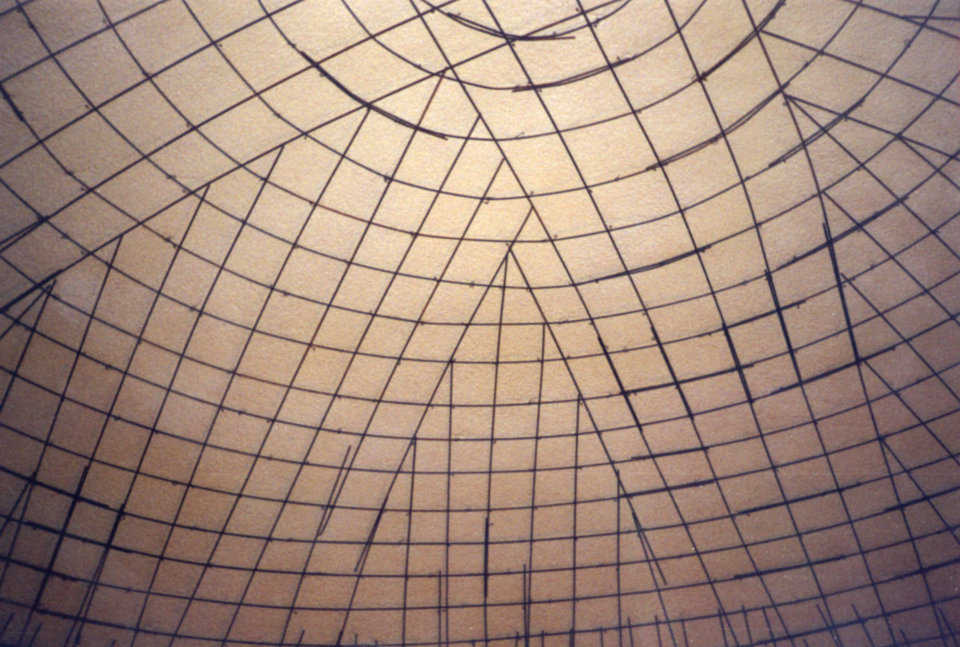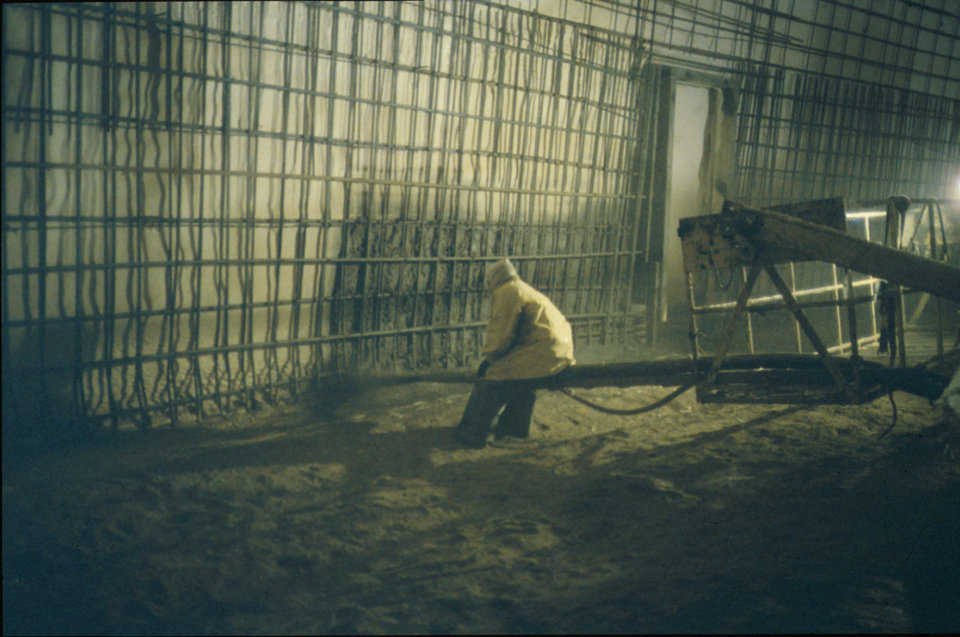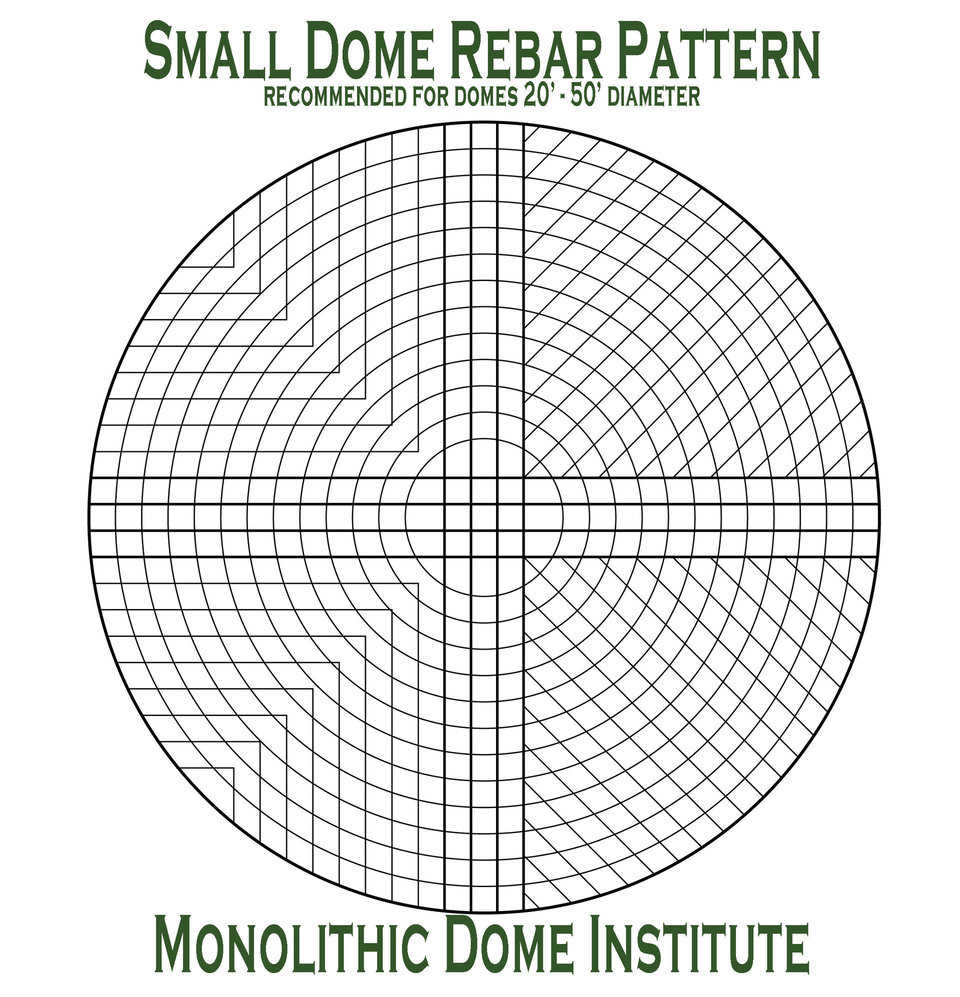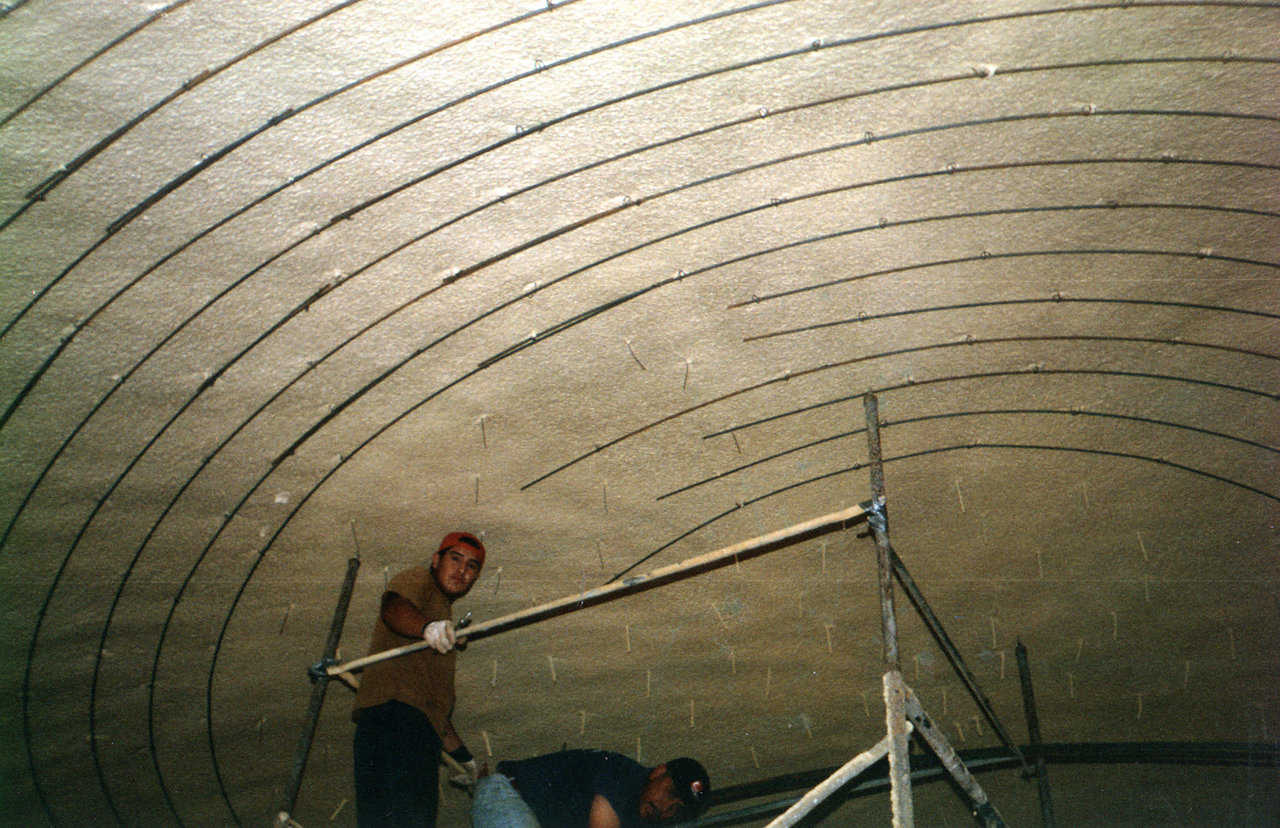Why Rebar
It’s important to understand why we use rebar (reinforcing steel bar) in concrete. It’s used to absorb tension forces in concrete, since concrete has very poor strength as a tension material.
For a driveway, rebar is generally placed as close as possible to the center of the thickness. Reason: the pressure on the driveway can be on the side or in the center.
But the most important location for rebar in a beam is the bottom where it will hold more. If the rebar were placed in the top, it would not hold much.
Rebar also helps move the temperature around in the concrete, mitigating the stresses created by uneven temperatures and shrinkage in the concrete. In places where this is the primary purpose for the rebar, it’s referred to as temperature steel. Rebar also helps measure the thickness of the shotcrete as it is applied.
In a Monolithic Dome, rebar is placed to counteract the tension forces within the concrete. Pressure can be or is applied to the dome from many sources: snow, wind, gravity, berming, burying, walking on the dome, hanging lights, sound systems, towers, falling airplane engines, attached structures, etc.
For the purpose of this article, only unloaded Monolithic Domes are considered. These include homes, schools, churches, etc. But buildings with towers on top, berming, suspended floors or bulk storages may require a different rebar layout. Certainly, additional engineering is needed for such additional loads.
Hoop Rebar
Rebar that actually does the most good to hold the dome up is hoop rebar that goes around the dome. Rebar going up and down are called verticals. Hoop rebar performs somewhat like the hoops on a barrel. Hence, they should be located as far toward the outside as is practical.
Obviously, rebar needs concrete surrounding it to glue it together. So hoop rebar should be about 5/8" to 1" from the outer surface of the concrete (bottom of the urethane foam). For a Monolithic Dome, hoop rebar is placed first.
Codes
Most Monolithic Domes built as homes require a minimum thickness of 2.5" of concrete. Codes require rebar be placed not further apart than 5 times the thickness of the concrete. Hence, most of the rebar in smaller domes – up to 100’ in diameter – is placed at a minimum of 12" on center.
Lower portions of Monolithic Domes are generally thicker, so rebar can often be placed further apart. Always refer to the engineering sheets for each particular dome. Concrete, as it fills in around the rebar, becomes the glue that holds the rebar together and transfers tension from the concrete to the rebar.
Code calls for rebar to have 5/8" of cover on the outside surface – if the outside surface is protected from the weather (i.e. painted, covered with urethane foam or a tarp, otherwise protected from the elements). When a thickness of 2.5" of concrete is specified, the outside hoop rebar should be 5/8" in from the outside surface of the concrete.
Vertical Rebar
The vertical layer of rebar is laid against the hoops. If these rebar layers are 3/8" thick, it means that you are automatically 1 1/2" from the urethane to the inside surface of the rebar. Another 3/4" to 1" of concrete is needed to complete the 2.5" thick shell. If the rebar is very carefully placed, and the shotcrete operator is careful, all will go well for a 2.5" thick concrete shell.
For Monolithic Domes requiring thicker shells, rebar should still be placed to the outside. (Note: If concrete is in direct contact with the ground, 2" of concrete cover is required, if formed. If poured directly against the dirt, 3" is required.)
As pressure is applied to the Monolithic Dome, the dome will try to dimple immediately under the pressure. Adjacent to that area, the dome will try to buckle outward, but will be prevented from doing so by the hoop bars. Therefore, hoop bars should always be on the outside surface next to the urethane foam. Just as hoops on a wooden barrel do no good on the inside of the barrel, hoops on a concrete dome need to be to the outside. If they are on the inside, they can be more easily ripped out of the concrete when unbalanced pressures are applied to the dome.
Rebar Footing
Vertical rebar is placed on the interior of the hoop rebar and wired immediately to the hoop rebar, except as the rebar approaches the footing. As the rebar cage approaches the footing, the vertical rebar out of the footing should be directly in the center of the dome shell for a short distance above the footing.
This short distance varies by size of the dome, but generally 10% of the height is an effective distance. Here the vertical rebar acts to prevent moment connection problems between the dome and the footing. To recap: For the bottom 10% of the dome, vertical steel must be carefully placed to remain in the center of the shell concrete.
We have learned that it takes effort to keep the hoop bar within 5/8" to 1" of the foam. There is always a tendency on the part of the workers to pull to the inside to fasten the bar in place – especially as they fasten the vertical bars to the horizontal bars. This continual tugging tends to move the bars outward from the foam – inward toward the dome.
Workers must be instructed to hold against the rebar as they tighten the rebar ties. All other rules of placing rebar should be followed. It is important that hoop bars be securely tied to each other at the lap. Much strength is added to the structure by hoop bars.
Concrete Thickness
For simple shells, it is often mistakenly thought that as the concrete thickness increases the placement of the rebar should be moved more toward the center of the concrete.
This is not so, unless the shell is subjected to non-symmetrical loads, such as a tower placed on it, bulk product stored in it, or the shell itself buried. In these cases, engineering may be substantially different.
But for most simple shells, hoop rebar should be 5/8" to 1" inch away from the urethane foam. A way of achieving this is to tie it as close as reasonable to the urethane and then chair it off where it might not hang far enough away from the urethane. This is far better than finding yourself with rebar hanging 2" to 3" away from the urethane and spraying extra concrete that just adds weight.
Concrete should be applied in even passes over the entire structure. Great care should be used to ensure rebar is embedded within the concrete.
Often shotcrete operators are tempted to spray concrete too dry. When it is sprayed too dry – without enough slump – it tends to lay on the surface of the rebar rather than encasing it. Once the hoop bars are encased, the building is generally pretty solid. When all bars are covered, most buildings are structurally sound forever. The information presented here is for non-loaded domes up to approximately 250’ in diameter.
Rebar Schedule
The engineer should show the rebar position in a clear, concise manner. The rebar schedule has been developed over many years and is the preferred method of detailing the general rebar layout. It is simple. It is very plain. It tells the story.
Also, read about Basalt Rebar.
Note: We first presented this information in 2008 and updated it in 2012.

Steel reinforcement ready for shotcrete application

Shotcrete application on a large Monolithic Dome — Shotcrete should be applied in even passes over the entire structure with rebar well-embedded within the concrete.

Rebar pattern recommended for small diameter domes (20’-50’).
Note: The two variations shown.
